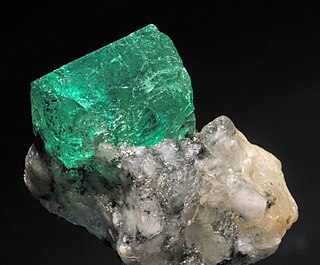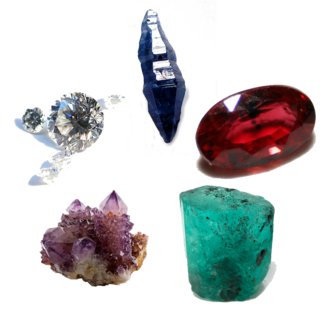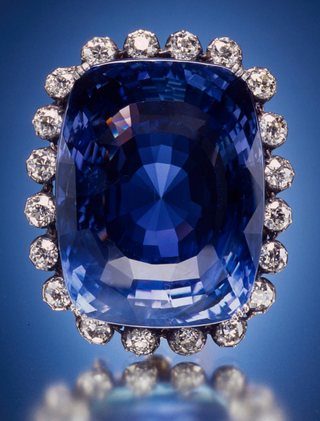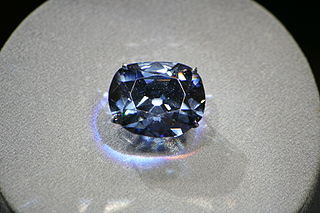Related Research Articles

Emerald is a gemstone and a variety of the mineral beryl (Be3Al2(SiO3)6) colored green by trace amounts of chromium or sometimes vanadium. Beryl has a hardness of 7.5–8 on the Mohs scale. Most emeralds have many inclusions, so their toughness (resistance to breakage) is classified as generally poor. Emerald is a cyclosilicate.

A gemstone is a piece of mineral crystal which, when cut or polished, is used to make jewelry or other adornments. Certain rocks and occasionally organic materials that are not minerals may also be used for jewelry and are therefore often considered to be gemstones as well. Most gemstones are hard, but some softer minerals such as brazilianite may be used in jewelry because of their color or luster or other physical properties that have aesthetic value. However, generally speaking, soft minerals are not typically used as gemstones by virtue of their brittleness and lack of durability.

Sapphire is a precious gemstone, a variety of the mineral corundum, consisting of aluminium oxide (α-Al2O3) with trace amounts of elements such as iron, titanium, cobalt, lead, chromium, vanadium, magnesium, boron, and silicon. The name sapphire is derived from the Latin word sapphirus, itself from the Greek word sappheiros (σάπφειρος), which referred to lapis lazuli. It is typically blue, but natural "fancy" sapphires also occur in yellow, purple, orange, and green colors; "parti sapphires" show two or more colors. Red corundum stones also occur, but are called rubies rather than sapphires. Pink-colored corundum may be classified either as ruby or sapphire depending on the locale. Commonly, natural sapphires are cut and polished into gemstones and worn in jewelry. They also may be created synthetically in laboratories for industrial or decorative purposes in large crystal boules. Because of the remarkable hardness of sapphires – 9 on the Mohs scale (the third hardest mineral, after diamond at 10 and moissanite at 9.5) – sapphires are also used in some non-ornamental applications, such as infrared optical components, high-durability windows, wristwatch crystals and movement bearings, and very thin electronic wafers, which are used as the insulating substrates of special-purpose solid-state electronics such as integrated circuits and GaN-based blue LEDs. Sapphire is the birthstone for September and the gem of the 45th anniversary. A sapphire jubilee occurs after 65 years.

The Hope Diamond is a 45.52 carats diamond that has been famed for its great size since the 18th century. Extracted in the 17th century from the Kollur Mine in Guntur, India, the Hope Diamond is a blue diamond. Its exceptional size has revealed new information about the formation of diamonds.

Tanzanite is the blue and violet variety of the mineral zoisite, caused by small amounts of vanadium. Tanzanite belongs to the epidote mineral group. Tanzanite is only found in Simanjiro District of Manyara Region in Tanzania, in a very small mining area approximately 7 km (4.3 mi) long and 2 km (1.2 mi) wide near the Mererani Hills.

The National Museum of Natural History (NMNH) is a natural history museum administered by the Smithsonian Institution, located on the National Mall in Washington, D.C., United States. It has free admission and is open 364 days a year. With 4.4 million visitors in 2023, it was the second most-visited museum in the United States.

The Allnatt Diamond is a diamond measuring 101.29 carats with a cushion cut, rated in color as Fancy Vivid Yellow by the Gemological Institute of America. This diamond was named after one of its holders, Major Alfred Ernest Allnatt, a soldier, sportsman, art patron and benefactor.

A chemically pure and structurally perfect diamond is perfectly transparent with no hue, or color. However, in reality almost no gem-sized natural diamonds are absolutely perfect. The color of a diamond may be affected by chemical impurities and/or structural defects in the crystal lattice. Depending on the hue and intensity of a diamond's coloration, a diamond's color can either detract from or enhance its value. For example, most white diamonds are discounted in price when more yellow hue is detectable, while intense pink diamonds or blue diamonds can be dramatically more valuable. Of all colored diamonds, red diamonds are the rarest. The Aurora Pyramid of Hope displays a spectacular array of naturally colored diamonds, including red diamonds.
The Heart of Eternity is a diamond measuring 27.64 carats, rated in color as "Fancy Vivid Blue" by the Gemological Institute of America. The Heart of Eternity was cut by the Steinmetz Group, who owned the diamond before selling it to the De Beers Group.
The Moussaieff Red Diamond is a diamond measuring 5.11 carats with a triangular brilliant cut, rated in color as Fancy Red by the Gemological Institute of America. It is the world's largest known red diamond, the rarest of all diamond colors.
The Pink Star, formerly known as the Steinmetz Pink, is a diamond weighing 59.60 carats, rated in color as Fancy Vivid Pink by the Gemological Institute of America. The Pink Star was mined by De Beers in 1999 in South Africa, and weighed 132.5 carats in the rough. The Pink Star is the largest known diamond having been rated Vivid Pink. As a result of this exceptional rarity, the Beny Steinmetz Group called Steinmetz Diamonds took a cautious 20 months to cut the Pink. It was unveiled in Monaco on 29 May 2003 in a public ceremony.
The Pumpkin Diamond is a diamond weighing 5.54 carats rated in color as Fancy Vivid Orange by the Gemological Institute of America. While this may seem small when compared to other famous diamonds, the Pumpkin Diamond is, in fact, one of the largest Fancy Vivid Oranges the GIA reports having rated and is unique compared to other orange diamonds because it is light-colored and notably intense. The Pumpkin Diamond was mined in Central African Republic and then imported into South Africa for sale, it was later cut and polished by William Goldberg, and put to auction at Sotheby's where it was bought by Ronald Winston of the House of Harry Winston for the price of $1.3 million. It is currently estimated to be valued at $3 million.

The Logan Sapphire is a 422.98-carat (84.596 g) sapphire from Sri Lanka. One of the largest blue faceted sapphires in the world, it was owned by Sir Victor Sassoon and then purchased by M. Robert Guggenheim as a gift for his wife, Rebecca Pollard Guggenheim, who donated the sapphire to the Smithsonian Institution in 1960. The sapphire's name is derived from Rebecca's new surname after marrying John A. Logan. It has been displayed in the National Gem Collection of the National Museum of Natural History in Washington, D.C., since 1971. It is a mixed cushion-cut sapphire, approximately the size of a large chicken egg, and set in a silver and gold brooch surrounded by 20 round brilliant-cut diamonds.

The Aurora Butterfly of Peace diamond collection is an artwork consisting of 240 natural, fancy colored diamonds weighing a combined total of 167 carats (33.4 g). This butterfly-shaped diamond mosaic was created over a period of twelve years by Alan Bronstein and Harry Rodman. The Aurora Butterfly of Peace was conceived as an eternal icon of love, beauty, energy, nature and peace.

Gemstone irradiation is a process in which a gemstone is artificially irradiated in order to enhance its optical properties. High levels of ionizing radiation can change the atomic structure of the gemstone's crystal lattice, which in turn alters the optical properties within it. As a result, the gemstone's color may be significantly altered or the visibility of its inclusions may be lessened.

Goldner, Chris T.. "Ocean Paradise Diamond - Natural Green Blue Diamond". StAugustine.com. Archived from the original on 2013-08-11. Retrieved 29 August 2013.

Blue diamond is a type of diamond which exhibits all of the same inherent properties of the mineral except with the additional element of blue color in the stone. They are colored blue by trace impurities of boron within the crystalline lattice structure. Blue diamonds belong to a subcategory of diamonds called fancy color diamonds, the generic name for diamonds that exhibit intense color.

A red diamond is a diamond which displays red color and exhibits the same mineral properties as colorless diamonds. Red diamonds are commonly known as the most expensive and the rarest diamond color in the world, even more so than pink or blue diamonds, as very few red diamonds have been found. Red diamonds, just like pink diamonds, are greatly debated as to the source of their color, but the gemological community most commonly attributes both colors to gliding atoms in the diamond's structure as it undergoes enormous pressure during its formation.
References
- 1 2 "The Ocean Dream". Gemological Institute of America. Archived from the original on July 3, 2007. Retrieved April 13, 2005.
- 1 2 "The Ocean Dream". The Splendor of Diamonds. Smithsonian Museum of Natural History. Archived from the original on May 5, 2006. Retrieved April 13, 2005.
- ↑ "Exhibit Information". The Splendor of Diamonds. Smithsonian Museum of Natural History. Archived from the original on April 29, 2006.